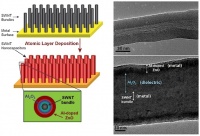Crucially, the researchers at Rice University say it is robust and can operate in extreme environments, and so could potentially be integrated into the manufacture of panels in items such as satellites and electric vehicles.
Standard capacitors that regulate flow or supply quick bursts of power can be discharged and recharged hundreds of thousands of times. Electric double-layer capacitors (EDLCs), generally known as supercapacitors, are hybrids that hold hundreds of times more energy than a standard capacitor, like a battery, while retaining their fast charge/discharge capabilities.
But traditional EDLCs rely on liquid or gel-like electrolytes that can break down in very hot or cold conditions. In Rice’s supercapacitor, a solid, nanoscale coat of oxide dielectric material replaces electrolytes entirely.
The key to high capacitance is giving electrons more surface area to inhabit, the researchers say. For this, the new device relies on numerous bundles of single-walled carbon nanotubes (SWNT) 15–20 in nanometre in diameter and up to 50 microns long, essentially grown as a carpet-like array.
The array is then transferred to a copper electrode with thin layers of gold and titanium to aid adhesion and electrical stability.
The nanotube bundles (the primary electrodes) are doped with sulphuric acid to enhance their conductive properties; then they were covered with thin coats of aluminium oxide (the dielectric layer) and aluminium-doped zinc oxide (the counterelectrode) through a process called atomic layer deposition (ALD). A top electrode of silver paint completed the circuit.
‘Essentially, you get this metal/insulator/metal structure,’ said Cary Pint of Rice, who is the lead author of the published research. ‘No one’s ever done this with such a high-aspect-ratio material and utilising a process [such as] ALD.’
Pint said the supercapacitor holds a charge under high-frequency cycling and can be naturally integrated into materials. He envisages an electric car body that is a battery, or a microrobot with an on-board, non-toxic power supply that can be injected for therapeutic purposes into a patient’s bloodstream.






Nanogenerator consumes CO2 to generate electricity
Whoopee, they've solved how to keep a light on but not a lot else.